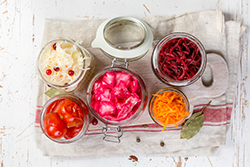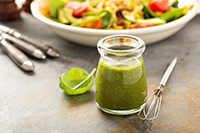Probiotics have been promoted and advertised as helping to cure diarrhea, help with weight loss, fight depression, heal stomach troubles and so much more. People usually come into a consult aware of the benefits of probiotics, but the question is “Are they really worth all the hype? And How do I know if I am taking the right probiotic?”.
This month I’m breaking down this topic for you. Clarifying not only what probiotics are, but also what strains to use for your health issues as well as where to find them. Remember, while I work really hard to provide you with valuable information, a personalized consultation will help ensure your nutrition and supplement plan is designed for optimal health and well-being.
-Stephanie
|
|
|
Probiotics 101: What They Are and When to Use
|
 Probiotics are live bacteria and yeasts similar to the microorganisms that naturally live in your gut. They help promote a healthy bacteria balance in the gut by counteracting unhealthy gut bacteria from a poor diet, inflammation, antibiotics, and illnesses. Probiotics help restore the natural balance of gut bacteria. Probiotics are live bacteria and yeasts similar to the microorganisms that naturally live in your gut. They help promote a healthy bacteria balance in the gut by counteracting unhealthy gut bacteria from a poor diet, inflammation, antibiotics, and illnesses. Probiotics help restore the natural balance of gut bacteria.
When it comes to probiotics, scientists have discovered there’s a wide variety of different types and therefore probiotics are differentiated by the strain of bacteria. If you’ve ever looked for a probiotic, you’ve probably been a little overwhelmed and confused with the long and complicated names and you’ve probably wondered, “I was told to take a probiotic but what does Lactobacillus acidophilus or Bifidobacteria longum even mean?”
In an effort to help simplify things, I’m sharing a few common strains of probiotics, what they are used to help treat, and where to find them.
Lactobacillus acidophilus (L. acidophilus)
Primary Purpose:
- Digestion and overall general health. L. acidophilus helps break down sugars such as lactose, into lactic acid. It is also known for protecting against harmful germs.
May also help:
- Reduce cholesterol
- Improve symptoms associated with chronic fatigue syndrome
- Prevent or reduce diarrhea
- Improve symptoms of IBS
- Treat and prevent vaginal yeast infections
- Boost immune system
Found in: Naturally found in fermented foods such as sauerkraut, miso, and tempeh. Commonly added to foods such as cheese and yogurt as a probiotic. Can also be found in a supplement.
Lactobacillus rhamnosus (L. rhamnosus)
Primary purpose:
- Prevent and treat a variety of types of diarrhea, specifically antibiotic related diarrhea.
May also help:
- Relieve symptoms of irritable bowel syndrome (IBS)
- Improve overall gut health.
- The antimicrobial properties of L. rhamnosus may also help protect against cavities
Found in: Supplements and often added to dairy products such as yogurt, cheese, and milk.
Lactobacillus casei (L. casei)
Primary Purpose:
- Prevent and treat diarrhea, including infectious diarrhea, traveler’s diarrhea and diarrhea associated with taking antibiotics.
May also help:
- Reduce symptoms of other digestive issues such as constipation, chron’s disease, IBD (inflammatory bowel disease), IBS (irritable bowel syndrome) and ulcerative colitis.
Found in: Fermented foods such as some yogurts, milk, and cheeses. Also found in supplements.
Bifidobacteria longum (B. longum)
Primary Purpose:
May also help:
- Decrease inflammation
- Decrease cholesterol
- Improve gut health
- Boost brain function
- Improve mood
Found in: Naturally found in fermented foods such as sauerkraut, yogurt, kefir, kombucha, tempeh and miso
Saccharomyces Boulardii (S. Boulardii)
Primary Purpose:
- Treating rotaviral diarrhea in children and diarrhea caused by antibiotics.
May also help:
- Acne
- Diarrhea caused by “bad” bacteria overgrowth in adults,
- Traveler’s diarrhea
- Diarrhea associated with tube feeding
Found in: S. Boulardii is actually yeast and easiest to take in the over-the-counter supplement form. Can also be found in African fermented foods such as kenkey, ogi, and amasi.
|
|
|
Recap 10 Probiotic Rich Foods
|

- Yogurt
- Kefir
- Sauerkraut
- Water or brine-cured olives
- Kombucha
- Pickles
- Traditional Buttermilk
- Cottage Cheese
- Miso
- Tempeh
|
|
Featured Recipe
Green Goddess Dressing
|
 Recipe by: Siggi’s Recipe by: Siggi’s
Ingredients- 1 cup siggi’s 0% plain skyr
- ½ avocado
- 1 clove garlic, crushed
- ½ cup parsley, roughly chopped
- ¼ cup tarragon, roughly chopped
- ¼ cup chives, roughly chopped
- 3 Tbsp milk
- 2 Tbsp extra virgin olive oil
- 1Tbsp lemon juice
- salt and pepper, to taste
Preparation
Combine siggi’s skyr with remaining ingredients in a food processor or immersion blender and puree until smooth. Enjoy as a salad dressing or a dip with vegetables.
Makes 16 servings, Serving Size: 2 Tbsp
Nutrition Facts Per Serving: Calories 40, Protein 2g, Total Fat 2.5g, Saturated Fat 0g, Cholesterol 0mg, Sodium 30mg, Total Carbohydrates 2g, Sugars less than 1g
|
|
|
Be Inspired
|
|
“Our body teaches us that health lies in balance and harmony, rather than in conflict and fighting.”
- Ilchi Lee
|
|
|
About SO Nutrition
|
 Stephanie Leipprandt Ouellette, MBA, RDN, LD
Stephanie Leipprandt Ouellette, MBA, RDN, LD Stephanie has been working in the field of nutrition and dietetics since 1995. She earned a Bachelor of Science degree in Dietetics from Michigan State University, completed an Approved Pre-Professional Practice Program at Western Michigan University and earned a Master of Business Administration from Baker College. She’s been a Registered Dietitian Nutritionist since 1996 and licensed in Texas since 2007. In 2008, Stephanie earned her certification in Childhood and Adolescent Weight Management. Stephanie has extensive clinical & managerial experience, both in corporate settings and in the community. Now she wants to share her knowledge with you, because most (if not all) nutritional habits begin at home.
Stephanie and her family reside in Katy, Texas
|
|
| |
Copyright © 2019 Customized Nutrition Newsletters, All rights reserved.
|
|
| |
|
|